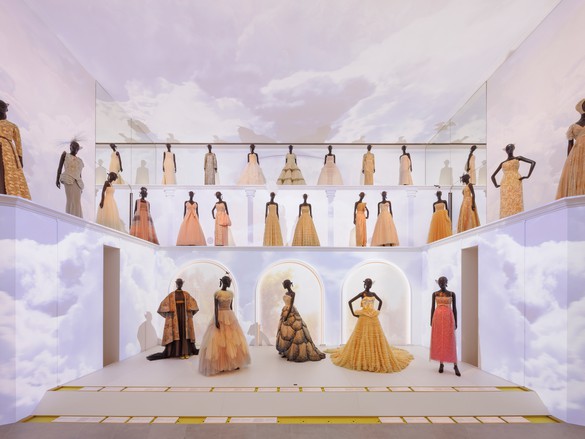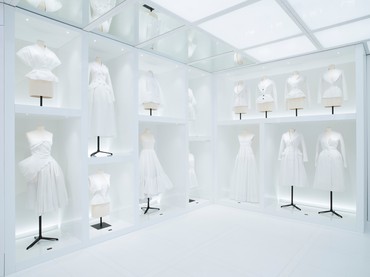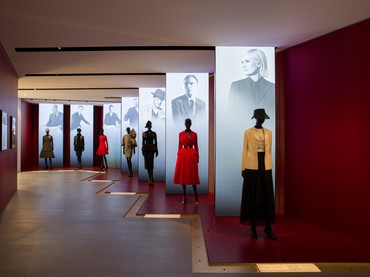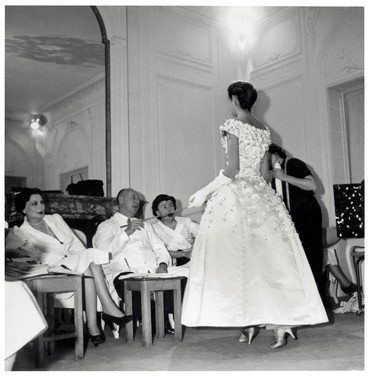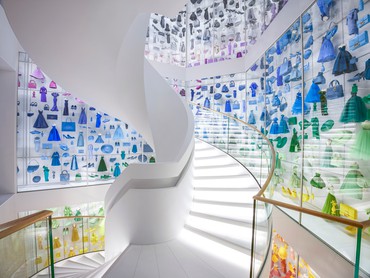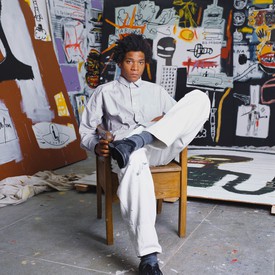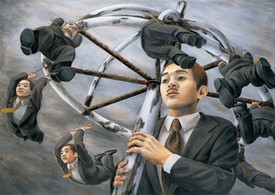
Wyatt Allgeier is a writer and an editor for Gagosian Quarterly. He lives and works in New York City.
In 1946, Christian Dior, the eponymous founder of the Parisian fashion house, set up his atelier at 30 Montaigne in Paris. From these headquarters, Monsieur Dior would debut his celebrated New Look and the Miss Dior fragrance. 30 Montaigne continued to evolve over the years, remaining the primary office and atelier while expanding into a boutique, a location for fashion shows, and a meeting place for artists, actors, writers, and others. Now, after over two years of renovations, the building is reopening with reverential nods to the past and bold innovations for the future.
Among new additions, the brand has added a permanent space for the exhibition of archival documentation and clothing from the house’s history. Entitled La Galerie Dior, the exhibition space aims to guide viewers through the personal and creative histories of Christian Dior and his successors.
Wyatt AllgeierNathalie, thank you for taking the time to speak today. Before we discuss La Galerie Dior, I’d love to learn more about your education and career up to this point in time. How did you end up starting NC Agency, and taking on this career as a scenographer?
Natalie CrinièreI began my career at the Centre Pompidou. I worked on a variety of exhibitions there, but in 2000 I decided that I wanted to start my own office and work more broadly with a lot of different institutions. My first experience working in a fashion context was with Yves Saint Laurent and Pierre Bergé for an exhibition at the Centre Pompidou on Jean Cocteau; as you know, they were friends with Cocteau. That project then developed into an exhibition on Yves Saint Laurent’s clothing. After that, Dior asked me to make an exhibition for them, and the rest is history.
WACould you tell me about your first exhibition with Dior?
NCThe first one that I worked on was at the Pushkin State Museum of Fine Arts in Moscow in 2011, where we created a very beautiful exhibition that included a lot of paintings. After that, I continued to work with Dior on the exhibition Christian Dior: Designer of Dreams, which debuted at the Musée des Arts Décoratifs in Paris, in 2017, then traveled to London, Doha, and New York.
WASo the exhibition at 30 Montaigne builds off those earlier presentations?
NCChristian Dior: Designer of Dreams was telling a particular story about Christian Dior, and because it was presented at art museums, there were different considerations, a different audience. The exhibition at La Galerie Dior is less limiting for this reason, and what is really particular is that this is the place where Christian Dior himself began. We have that historical arc to build on here at 30 Montaigne. I felt it was absolutely essential to honor the soul of the building and the souls of all the designers who have worked in this space. So it really is a different endeavor from the traveling exhibition. And as the atelier is still at work in this building, it’s really a global experience in terms of the audience that will encounter this space.
WAIs the show structured chronologically, or is there a different logic?
NCWe began by asking ourselves, What is the story of the building? The idea is to bring people into and through the office of Christian Dior, this unique space. I made my own story for the experience. People arrive and they meet Christian Dior, and in the middle of the building we have a garden, since Dior was very inspired by gardens. And after this encounter with the founder, we have thematic sections where the designers that have been a part of the Dior legacy—Maria Grazia, John Galliano, Raf Simons, and many more—are interspersed in response to the architecture and history of the building.
WAWhat are some of your favorite materials, whether they are archival images or the actual Dior clothing?
NCEach time we make another museum exhibition, we find new things because there are so many artifacts. The Dior house has kept incredible records; they have a lot of documentation. We have documentation from Christian Dior himself. In the first room, when you begin with the story of Christian Dior, you see him from the very beginning, from the time he was a baby.
WAWill the exhibition change over time, or is it fairly permanent?
NCThis space is permanent but the installations—the displays and objects within them—are designed to transform over time; you can change a color, you can change a material. And you have to change the clothing, because unlike a painting, for example, these items are not created to stay in one place for more than six months. So the floor, the settings, the levels, everything can change, and you can really have a new presentation.
WAI didn’t even think about the archival nature of dresses and how they have to be taken care of. It’s fascinating. Are there accessories on display as well?
NCYes, we have a room where we show original accessories, and they are really presented like art pieces. And we have a special display called the Diorama, where 3D-printed objects based off original Dior products are created in different colors.
WAWhat were some of your hopes for the space and people’s experience at La Galerie Dior? What do you hope they walk away with emotionally or educationally?
NCI think it’s an intimate way of visiting an exhibition, because all the dresses are at the same level as the viewer. There aren’t any podiums or plinths. You’re really face to face with the clothing and the archival materials. And we managed to avoid glass throughout, which was important to me. You can really take in all of the details.
And we also included video and audiovisual materials to bring movement into the experience. It brings it to life, so to speak. For example, we’ve installed two videos that animate the garden at night. You’ve got some moonlight, you have this idea that the flowers are moving. So it’s simple; we don’t push that in your eyes, but if you look, it’s very delicate.
Photos: courtesy Dior
